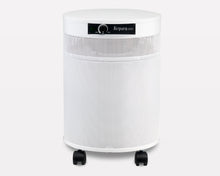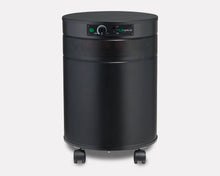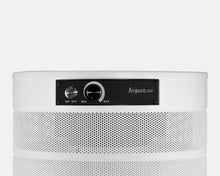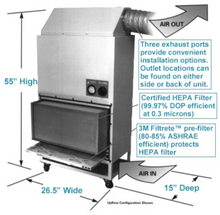Air Changes Per Hour (ACH) Explained: Why It Matters for Virus Control in Busy Spaces

In today's world, where the focus on indoor air quality has never been more pronounced, understanding how effectively air is circulated and cleaned within a space is paramount. Whether you're managing a bustling office, a lively retail store, a classroom, or even your own home, the air you breathe significantly impacts health and well-being. At Commercial Air Purifiers, LLC, we are dedicated to bringing the best air purifiers to the market, and central to our mission is educating our customers on crucial metrics like Air Changes Per Hour (ACH).
But what exactly is ACH, and why does it hold such sway in the fight against airborne viruses and other contaminants? It’s more than just a technical term; it's a vital indicator of how quickly and thoroughly the air in a room is being replaced or filtered. This article, penned by the experts at Commercial Air Purifiers, LLC, will dive deep into the world of ACH, explaining its significance for virus control, how to calculate it for your space, and what recommendations you should consider for a truly healthy indoor environment.
The Invisible Threat: Why Indoor Air Quality is a Major Concern
Before we unpack ACH, let's establish the "why." We spend a vast majority of our lives indoors – in offices, schools, homes, and public venues. While these spaces offer shelter and comfort, they can also become breeding grounds for invisible threats, particularly airborne viruses. The COVID-19 pandemic vividly underscored the ease with which respiratory viruses can spread through shared air, even from asymptomatic individuals.
Beyond viruses, indoor air can harbor a cocktail of pollutants:
-
Particulate Matter (PM2.5): Tiny particles from dust, pollen, pet dander, and even cooking or outdoor pollution that can penetrate deep into the lungs.
-
Volatile Organic Compounds (VOCs): Gases emitted from everyday products like cleaning supplies, paints, and furnishings, contributing to "sick building syndrome."
-
Allergens: Microscopic triggers like dust mites, mold spores, and pollen that can exacerbate allergies and asthma.
The impact of poor indoor air quality extends beyond immediate illness. Chronic exposure can lead to a range of health issues, from respiratory problems and cardiovascular disease to reduced cognitive function and fatigue. According to the World Health Organization (WHO), air pollution is recognized as the biggest global health threat in the current century, with both ambient (outdoor) and indoor air pollution contributing to millions of premature deaths annually. This stark reality emphasizes the urgent need for effective indoor air quality management strategies.
Understanding Air Changes Per Hour (ACH): The Core Metric
Air Changes Per Hour (ACH), sometimes referred to as Air Changes per Hour (ACPH), is a fundamental metric in ventilation and air purification. Simply put, ACH measures how many times the entire volume of air within a room is theoretically replaced or filtered in one hour.
Imagine a bucket of water. If you empty and refill that bucket five times in an hour, you've achieved five "water changes" per hour. ACH applies the same principle to air. A higher ACH indicates more frequent air turnover, meaning that airborne contaminants, including viral particles, are diluted and removed from the space more rapidly.
How is ACH achieved? ACH is a combined effort of various elements:
-
Natural Ventilation: Opening windows and doors allows outdoor air to dilute indoor pollutants. While simple, it's often unreliable and dependent on external weather and air quality conditions.
-
Mechanical Ventilation (HVAC Systems): Heating, Ventilation, and Air Conditioning (HVAC) systems are designed to introduce fresh outdoor air and exhaust stale indoor air. The effectiveness of an HVAC system in achieving a desired ACH depends on its design, maintenance, and filter efficiency.
-
Portable Air Purifiers: These devices actively filter the air within a room, contributing to what's often called "Equivalent Air Changes Per Hour" (eACH). They are particularly valuable for supplementing existing ventilation or in spaces where mechanical ventilation is inadequate or non-existent.
The Critical Role of ACH in Virus Control
When it comes to controlling the spread of airborne viruses, ACH is a game-changer. Viruses like influenza and SARS-CoV-2 (the virus that causes COVID-19) can linger in the air as aerosols, microscopic particles that can travel far beyond the immediate vicinity of an infected person. The longer these viral aerosols remain suspended, the higher the risk of transmission to others.
Increasing ACH actively works to mitigate this risk in several ways:
-
Dilution: By introducing clean air and removing contaminated air more frequently, the concentration of viral particles in the air is diluted. Think of it like adding clean water to a pool with a small amount of dye – the more clean water you add, the less concentrated the dye becomes.
-
Removal: When air is exhausted or passed through efficient filters (like HEPA filters in air purifiers), viral particles are physically removed from the air, preventing them from being inhaled.
-
Reduced Exposure Time: With faster air changes, individuals in the space are exposed to viral particles for shorter durations, decreasing the likelihood of inhaling an infectious dose.
What's the Recommended ACH for Virus Control?
While there's no single, universally mandated ACH number for all spaces, leading health organizations and industry bodies provide strong recommendations, particularly in the context of respiratory virus mitigation.
-
The Centers for Disease Control and Prevention (CDC) suggests aiming for 5 or more air changes per hour (ACH) of clean air to help reduce the amount of viral particles in the air. This can be achieved through a combination of central ventilation, natural ventilation, or additional devices that provide equivalent ACH (eACH), such as portable air purifiers. It's important to note that higher ACH levels (e.g., those used in hospital airborne isolation rooms, often 6-12 ACH) may reduce infectious aerosols further, but balancing benefits with energy costs is key for most non-clinical settings.
-
The U.S. Environmental Protection Agency (EPA) echoes the CDC's recommendation, suggesting a target of 5 ACH as a goal to reduce viral particles in indoor spaces. They also emphasize a multi-layered approach, including upgrading HVAC filters to MERV 13 or higher and using portable air cleaners.
-
ASHRAE (American Society of Heating, Refrigerating and Air-Conditioning Engineers), a widely recognized authority in building systems, provides detailed standards for ventilation in various building types. While specific numbers vary by space type and occupancy, their guidelines for healthcare settings, for instance, often recommend much higher ACH rates for critical areas like airborne infection isolation rooms (AIIRs), emphasizing constant air circulation and removal of airborne contaminants. ASHRAE also recommends increasing ventilation rates and maintaining them 24/7, especially in buildings where known infections exist.
At Commercial Air Purifiers, LLC, we advocate for meeting or exceeding these recommendations whenever possible, leveraging the power of advanced air purification technology to achieve optimal eACH.
The Air Purifier ACH Calculator: Tailoring Solutions for Your Space
Understanding the concept of ACH is one thing; applying it to your specific environment is another. This is where an air purifier ACH calculator becomes an invaluable tool. Since Commercial Air Purifiers, LLC is committed to transparency and providing tangible value, we’ll walk you through the process.
To calculate the ACH for your space when using a portable air purifier, you need two key pieces of information:
-
Room Volume: This is the total cubic footage of the space you want to purify.
-
Formula: Length (feet) x Width (feet) x Ceiling Height (feet) = Room Volume (cubic feet)
-
-
Air Purifier's Clean Air Delivery Rate (CADR): CADR measures how quickly an air purifier removes pollutants (like smoke, dust, and pollen) from the air in a room. It’s typically measured in cubic feet per minute (CFM). A higher CADR indicates a more powerful and effective air purifier.
Once you have these two values, you can calculate the ACH provided by your air purifier:
-
Formula: (CADR (CFM) x 60) / Room Volume (cubic feet) = ACH
Example: Let's say you have a conference room that is 30 feet long, 20 feet wide, and has 10-foot ceilings. You are considering an air purifier with a CADR of 400 CFM.
-
Room Volume: 30 ft x 20 ft x 10 ft = 6,000 cubic feet
-
ACH Calculation: (400 CFM x 60) / 6,000 cubic feet = 24,000 / 6,000 = 4 ACH
In this example, a single air purifier with a 400 CFM CADR would provide 4 ACH for this conference room. Given the CDC's recommendation of 5+ ACH for virus control, you might consider adding a second air purifier or choosing a more powerful unit to reach the desired level.
Many air purifier manufacturers, including Commercial Air Purifiers, LLC, provide online ACH calculators. These tools simplify the process, allowing you to input your room dimensions and instantly see the recommended air purifiers or the number of units needed to achieve a target ACH. This empowers you to make informed decisions tailored to your unique space and needs.
Beyond the Numbers: Real-World Impact and Considerations
While the numbers are crucial, the real impact of optimized ACH is felt in the health and productivity of those occupying the space. Consider a real-world scenario:
Case Study: A Small Business Office
A small marketing agency with an open-plan office previously experienced frequent seasonal flu outbreaks and employee complaints about stuffy air. Their existing HVAC system provided minimal outdoor air ventilation, estimated at only 1-2 ACH.
After consulting with Commercial Air Purifiers, LLC, the agency implemented a strategy to increase their effective ACH. They installed several commercial-grade air purifiers strategically throughout the office, each chosen for its high CADR rating appropriate for the zones they covered. By calculating the combined eACH from these units, they collectively achieved an average of 6 ACH across their main workspace.
Results:
-
Within months, the agency reported a noticeable reduction in respiratory illness among staff during flu season.
-
Employees commented on fresher air and improved comfort.
-
Anecdotal evidence suggested increased focus and reduced fatigue, contributing to overall productivity.
This experience highlights that even without a complete overhaul of a building's HVAC system, targeted air purification can significantly enhance air quality and health outcomes.
Important Considerations for Achieving Optimal ACH:
-
Room Layout and Obstructions: Furniture, walls, and other physical barriers can affect air circulation. Strategic placement of air purifiers is crucial to ensure even distribution of filtered air.
-
Occupancy Levels: Spaces with higher occupancy will naturally have a greater concentration of exhaled viral particles. Therefore, they often require higher ACH rates to maintain a safe environment.
-
Source Control: While ACH is vital, it's part of a broader strategy. Reducing the source of pollutants (e.g., using low-VOC products, regular cleaning) remains important.
-
Filter Quality: The effectiveness of an air purifier in achieving eACH is directly linked to the quality of its filters. HEPA (High-Efficiency Particulate Air) filters are the gold standard, capable of capturing 99.97% of airborne particles 0.3 microns in size, including many viruses and bacteria.
-
Continuous Operation: To maintain consistent air quality and ACH levels, air purifiers should be run continuously, especially during occupied hours.
-
Maintenance: Regular filter replacement and maintenance of air purifiers and HVAC systems are critical to ensure they operate at peak efficiency and continue to provide the desired ACH.
Solutions and Recommendations from Commercial Air Purifiers, LLC
At Commercial Air Purifiers, LLC, our mission is to empower businesses and individuals with the knowledge and tools to create healthier indoor environments. Based on extensive experience and adherence to leading health guidelines, we offer the following recommendations:
-
Assess Your Current ACH: Utilize an air purifier ACH calculator (easily found online, including on our website) to determine your current air change rate. Measure your room's length, width, and ceiling height, and if you have an existing air purifier, find its CADR rating. This is your starting point.
-
Target a Minimum of 5 ACH for General Spaces: For most commercial, office, and residential spaces where virus control is a priority, aim for at least 5 ACH. In areas with higher foot traffic, vulnerable populations, or during periods of elevated community transmission, consider aiming for 6-8 ACH or even higher, particularly in spaces like medical clinics or waiting rooms, where 10-12 ACH is often recommended.
-
Invest in High-Quality Portable Air Purifiers: When your existing ventilation is insufficient, high-CADR portable air purifiers are an effective and flexible solution. Look for units equipped with true HEPA filters, which are proven to capture airborne viruses and other microscopic pollutants. At Commercial Air Purifiers, LLC, we stock a range of purifiers designed specifically for commercial use, offering robust filtration and high CADR ratings to achieve significant eACH.
-
Strategic Placement Matters: Don't just place an air purifier in a corner. Position units to maximize air circulation and filtration. In larger open spaces, multiple units may be necessary to ensure even air distribution and achieve the desired ACH across the entire area.
-
Complement with Ventilation: Where possible, combine air purification with increased natural or mechanical ventilation. Opening windows for short periods can help, and ensuring your HVAC system is well-maintained and using the highest possible MERV-rated filters (typically MERV 13 or higher for improved particulate capture) can significantly contribute to overall air changes.
-
Monitor and Maintain: Regularly monitor your indoor air quality, perhaps with a CO2 monitor as a proxy for ventilation effectiveness. Adhere to manufacturer recommendations for filter replacement for your air purifiers and schedule regular maintenance for your HVAC systems.
Conclusion: Breathing Easier with Better ACH
In a world increasingly aware of the invisible threats lurking in our indoor air, understanding and optimizing Air Changes Per Hour (ACH) is no longer a luxury but a necessity. From controlling the spread of viruses to reducing common indoor pollutants, a higher ACH translates directly to a healthier, safer, and more productive environment.
At Commercial Air Purifiers, LLC, we are committed to providing the cutting-edge air purification solutions that help you achieve optimal ACH, giving you confidence in the air you and others breathe. By taking proactive steps to calculate your ACH, implementing powerful air purifiers, and maintaining a layered approach to indoor air quality, you're not just investing in cleaner air; you're investing in health, well-being, and peace of mind.
Take control of your indoor air quality today. Explore our range of commercial-grade air purifiers and utilize our resources to determine the ideal ACH for your space. Let us help you create an environment where everyone can breathe easier.
About the Author:
This article was written by the expert team at Commercial Air Purifiers, LLC. With years of experience in the indoor air quality industry, we are dedicated to researching, sourcing, and providing the highest quality air purification solutions for businesses and individuals. Our commitment to health, safety, and scientific principles drives our product selection and our educational initiatives.
Publication Date: July 4, 2025
FAQ: Common Air Quality Concerns
Q1: How often should I run my air purifier to maintain ACH? A1: To maintain your target ACH, your air purifier should ideally run continuously during occupied hours. Many modern air purifiers have "auto" modes that adjust fan speed based on real-time air quality sensors, providing efficient operation.
Q2: Can one air purifier cover multiple rooms? A2: While a powerful air purifier might have some effect on adjacent spaces, ACH is calculated for a specific room volume. For optimal effectiveness and to achieve the recommended ACH in each space, it's generally best to size and place air purifiers for individual rooms, especially in larger homes or commercial buildings.
Q3: What's the difference between CFM and CADR? A3: CFM (Cubic Feet per Minute) is a general measurement of airflow. CADR (Clean Air Delivery Rate) is a more specific metric for air purifiers, indicating how much filtered air the unit delivers per minute for specific pollutants (e.g., smoke, dust, pollen). For assessing air purifier performance and calculating ACH, CADR is the more relevant metric.
Q4: Does higher ACH help with allergies or asthma? A4: Yes, absolutely. A higher ACH rate means the air is filtered more frequently, effectively reducing airborne allergens like pollen, dust mites, pet dander, and mold spores. This significantly benefits individuals with allergies or asthma, leading to fewer symptoms and improved respiratory health.
Q5: Are there other things I can do to improve indoor air quality besides air purifiers? A5: Yes, a multi-layered approach is always best. Beyond air purifiers, consider:
-
Increasing natural ventilation by opening windows when outdoor air quality is good.
-
Maintaining your HVAC system, ensuring filters are clean and of adequate MERV rating (MERV 13 or higher if your system can handle it).
-
Reducing indoor pollution sources (e.g., using low-VOC products, avoiding harsh chemical cleaners, keeping pets well-groomed).
-
Regular cleaning and vacuuming with a HEPA-filtered vacuum.
-
Controlling humidity levels to prevent mold growth.






